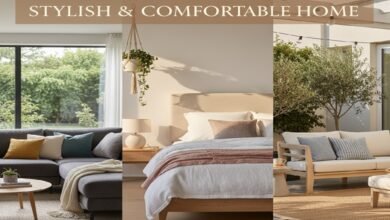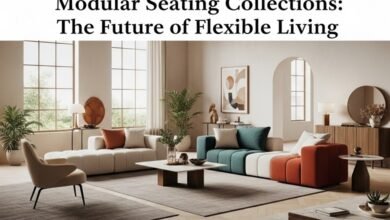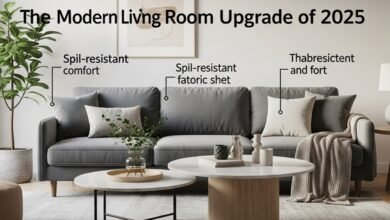Modular & Multifunctional Furniture: Redefining Modern Living
In 2025, furniture is no longer just about filling space—it’s about flexibility, efficiency, and style. With urban living spaces shrinking and the need for adaptable interiors growing, modular and multifunctional furniture has emerged as a game-changer. From sofas that transform into beds to tables that expand and contract, these pieces are reshaping how we live, work, and entertain. But how do they compare to traditional furniture, and why are they dominating modern interiors? Let’s explore.
The Concept of Modular Furniture 🧩🏡
Modular furniture consists of individual units or sections that can be arranged in multiple configurations. Think sofa sections that snap together, storage cubes that stack, or shelving units that reconfigure.
- Flexibility: You can change the layout depending on the occasion, season, or room size.
- Personalization: Each unit can be customized in color, material, and size.
- Ease of Moving: Ideal for renters and people who relocate frequently.
👉 Modular furniture turns interiors into dynamic, adaptive spaces rather than static rooms.
Multifunctional Furniture: Double the Functionality 🔄🛏️
Multifunctional furniture takes versatility further by combining two or more uses in a single piece. Examples include:
- Sofa beds for living rooms doubling as guest beds.
- Ottomans with hidden storage for clutter-free living.
- Foldable desks that serve as both workspace and dining tables.
- Murphy beds with integrated shelves or desks.
- Trend Appeal: Perfect for small apartments, home offices, and multipurpose rooms.
👉 Multifunctional furniture is practical, space-saving, and stylish, making it a staple for modern urban living.
Design & Aesthetic Versatility 🎨✨
- Traditional Furniture: Often static in design, emphasizing durability and classical aesthetics.
- Modular & Multifunctional Pieces: Focus on minimalism, clean lines, and adaptability. They fit multiple interiors—modern, Scandinavian, or industrial. Many brands now offer modular sofas, expandable dining tables, and convertible office units that complement contemporary décor.
👉 The design philosophy is “form meets function meets flexibility.”
Daily Utility vs. Occasional Use ⚡
- Modular Furniture: Perfect for daily adaptability—reconfiguring sofas for gatherings, adding storage units as needed, or rearranging seating for parties.
- Multifunctional Furniture: Shines in dual-purpose scenarios, like converting a guest room into a home office or optimizing studio apartments.
👉 Modular pieces excel in continuous versatility, while multifunctional pieces thrive in specific, high-impact moments.
Sustainability & Materials 🌱🪵
- Eco-Friendly Materials: Many modern modular pieces use recycled wood, bamboo, and low-VOC finishes.
- Durability: Multifunctional furniture is often engineered for longevity, reducing the need for frequent replacements.
- Customization: Removable covers, interchangeable units, and recyclable components increase sustainability.
👉 Modular and multifunctional furniture is not just space-efficient—it’s environmentally conscious.
Price Point & Investment 💰
- Traditional Furniture: Often cheaper initially but lacks adaptability, potentially requiring more purchases over time.
- Modular & Multifunctional Furniture: Can be more expensive upfront, but the long-term value is higher due to flexibility, durability, and multi-use functionality.
👉 Think of it as investing in versatility rather than just a single-purpose piece.
Trends Driving Popularity in 2025 📈🏠
- Urbanization & Smaller Spaces: Apartment living drives demand for space-efficient, multipurpose furniture.
- Remote Work Culture: Home offices need adaptable desks, chairs, and storage solutions.
- Customization & Personal Expression: Consumers want furniture that reflects their lifestyle and personality.
- Digital Integration: Smart desks, modular units with charging stations, and app-controlled adjustments are merging furniture with technology.
👉 Modern furniture is evolving to meet the dynamic lifestyle needs of 2025 households.
Strengths & Limitations ⚖️
- Strengths: Flexibility, space-saving, customizable, sustainable, stylish.
- Limitations: Higher upfront cost, requires planning for modular setups, and multifunctional pieces can be bulky if not well-designed.
👉 Despite minor limitations, the benefits of adaptability, design, and practicality far outweigh the drawbacks.
Final Verdict 🏆
Modular and multifunctional furniture represents the future of modern living spaces. It’s not just about saving space—it’s about creating interiors that evolve with you.
- Choose modular furniture for continuous adaptability and personalization.
- Choose multifunctional pieces for high-impact versatility in small spaces or dual-purpose rooms.
In 2025, the smartest homes combine both—crafting interiors that are efficient, stylish, and ready for any lifestyle change. 🛋️🔧✨



